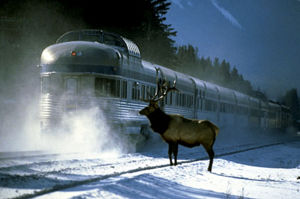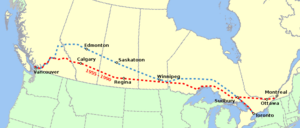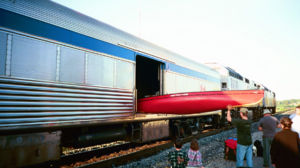The Canadian
The Canadian is a Canadian transcontinental passenger train originally operated by the Canadian Pacific Railway. It is currently operated by VIA Rail Canada (as the Canadian) with service between Union Station in Toronto, Ontario and Pacific Central Station in Vancouver, British Columbia. Before the current transcontinental service, the name "The Canadian" had been used on CPR's overnight Montreal / Chicago trains.
Canadian Pacific
In the years following World War II, passenger trains on the CPR consisted of a mixture of prewar heavyweight and pre- and post-war lightweight cars, even on their flagship transcontinental The Dominion and its eastern extension, The Atlantic Limited. While these cars were serviceable, American trains of the early 1950s, such as the California Zephyr, had already adopted streamlined all-stainless steel consists featuring domed observation cars. Following an evaluation in 1949 of the dome cars featured on the General Motors / Pullman Standard demonstrator Train of Tomorrow, CPR management, including then Vice-president Norris Crump resolved to upgrade their rolling stock. In 1953 CPR placed an order for 155 stainless steel cars with the Budd Company of Philadelphia that included 18 rear-end dome cars (Park series), 18 Skyline mid-train dome cars, 30 coaches, 18 dining cars and 71 sleeping cars (Manor and Chateau series). A subsequent order for 18 baggage-crew dormitory cars brought the final to total to 173 cars, sufficient for establishing an entirely new transcontinental service and partially re-equippiping The Dominion. The interior design of these new cars was contracted to the Philadelphia architectural firm Harbeson, Hough, Livingston & Larson (a company known for its industrial designs on other prominent passenger trains such as the Pioneer Zephyr), and the resulting furnishings and pastel-shaded colour schemes were widely acclaimed. After deciding to name the Park series dome cars after famous Canadian parks, leading Canadian artists, including members of the Group of Seven, were commissioned to paint suitable murals for these cars. When the decision was made to add budget sleeping cars, the Budd order was supplemented by 22 existing heavyweight sleepers that CPR refurbished in its own Angus Shops, each fitted out with Budd-style stainless steel cladding. To complement the new rolling stock, the CPR ordered General Motors Diesel FP9 locomotives to supplement an existing fleet of FP7s. Although these F-units remained the preferred power for the train, it was occasionally pulled by a variety of motive power, including Montreal Locomotive Works FPA-2s, and, as late as 1959, Steam locomotives.
CPR christened their new flagship train The Canadian and service began on April 24, 1955. Although CPR competitor Canadian National Railways began its own new transcontinental service, the Super Continental, on the same day, CPR was able to boast honestly that The Canadian was "The first and only all-stainless steel 'dome' stream-liner in Canada" — it was not until 1964 that the CNR acquired dome cars. CPR operated the train in two sections east of Sudbury, Ontario. The section operating between Montreal and Vancouver (also serving Ottawa) was known as train 1 westbound and train 2 eastbound, with a connecting section to or from Toronto splitting or joining at Sudbury (this section was known as train 11 westbound, and train 12 eastbound). Matching its streamlined appearance, The Canadian's 71 hour westbound schedule was 16 hours faster than that of The Dominion.
Although initially successful, passenger train ridership began to decline in Canada during the 1960s. Facing competition from airlines and increased automobile usage following construction of the Trans-Canada Highway, the CPR cancelled The Dominion in 1966, and petitioned the government to discontinue The Canadian in 1970. Although this petition was denied, CPR during the 1970s attempted to remove itself from the passenger service market. The Canadian was operated at reduced levels, with the government subsidising 80 percent of its losses.
VIA Rail
The federal Crown corporation VIA Rail Canada formally assumed responsibility for CPR's passenger services on October 29, 1978, although the VIA identity wasn't assumed by the trains themselves until the following summer. Following the takeover by VIA, the Canadian became the company's premier transcontinental train, and initially operated over its old CPR route. It was supplemented by the former CN Super Continental, which operated over the parallel, but more northerly, CN route. The Canadian continued to be operated in two sections east of Sudbury and provided daily service west to Vancouver and east to Toronto and Montreal.
In the aftermath of the deep budget cuts made to VIA Rail on January 15, 1990, the Super Continental service was abolished and the Canadian was moved from the CPR route to the Super Continental's CN route. This maintained transcontinental service and allowed VIA to operate its government-mandated service to small communities along the line. The CN route is widely acknowledged to be less scenic, particularly in the sections through the Rocky Mountains and north of Lake Superior. Service was also reduced to 3 days per week. Today, VIA Rail continues to operate the Canadian using the CN route with rebuilt ex-CPR Budd passenger equipment.
While some rail travel and heritage purists no longer consider this to be the true Canadian, VIA retains the name, train numbers, and equipment of the original.
References
- Classic Trains, Spring 2005, Kalmbach Publishing, ISSN 1527-0718 pg. 58-69



